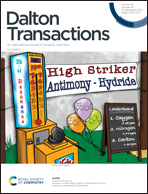Crystallinity after decarboxylation of a metal–carboxylate framework: indestructible porosity for catalysis†
Abstract
We report a curious case study of a Zr(IV)-carboxylate framework, which retains significant crystalline order after cascade thermocyclization of its linker components, and – more notably – after the crucial carboxylate links were severed by heat. Vigorous heat treatment (e.g., 450 °C and above) benzannulates the multiple alkyne groups on the linker to generate linked nanographene blocks and to afford real stability. The resultant Zr oxide/nanographene hybrid solid is stable in saturated NaOH and concentrated H3PO4, allowing a convenient anchoring of H3PO4 into its porous matrix to enable size-selective heterogeneous acid catalysis. The Zr oxide components can also be removed by strong hydrofluoric acid to further enhance the surface area (up to 650 m2 g−1), without collapsing the nanographene scaffold. The crystallinity order and the extensive thermal transformations were characterized by X-ray diffraction, scanning transmission electron microscopy (STEM), IR, solid state NMR and other instrumental methods.



 Please wait while we load your content...
Please wait while we load your content...